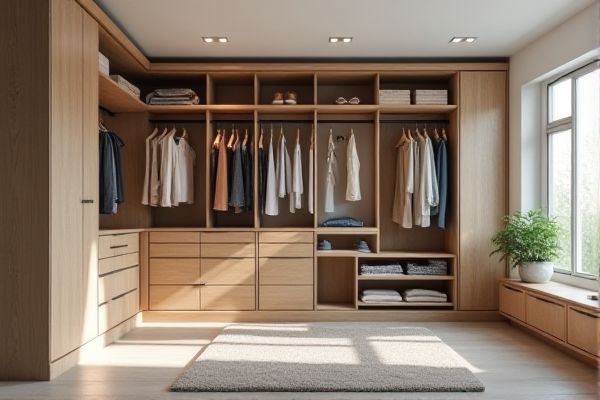
Hanging rods provide a streamlined, space-efficient solution for organizing your clothes, offering easy access and maximizing vertical storage, while freestanding closets deliver versatile, mobile storage that can be placed anywhere without installation. Explore the key differences and benefits of each option to determine which best suits your wardrobe needs and space constraints.
Table of Comparison
| Feature | Hanging Rod | Freestanding Closet |
|---|---|---|
| Installation | Wall-mounted; requires drilling | No installation; movable |
| Space Usage | Minimal footprint; uses vertical space | Takes up floor space; larger footprint |
| Capacity | Limited to rod length; best for hanging clothes | Multiple compartments; higher storage variety |
| Portability | Fixed; not portable | Portable; easy to move |
| Cost | Generally lower cost | Typically higher cost |
| Durability | Depends on wall support and rod quality | Self-supporting; usually sturdy |
| Customization | Limited to rod length and placement | Various designs and sizes available |
Introduction to Wardrobe Storage Solutions
Hanging rods maximize vertical space by allowing clothes to be stored on hangers, making garments easily accessible and wrinkle-free. Freestanding closets offer versatile storage with shelves, drawers, and compartments, suited for organizing folded clothes and accessories. Choosing the right wardrobe storage solution depends on space availability, type of clothing, and personal organization preferences.
What Is a Hanging Rod Closet?
A hanging rod closet consists of a sturdy horizontal bar designed to support hangers, allowing you to neatly store and organize clothes like shirts, jackets, and dresses. This type of closet maximizes vertical space and keeps garments wrinkle-free by suspending them rather than folding. Your choice in a hanging rod closet can enhance accessibility and visibility of your wardrobe compared to freestanding closets that may include shelves or drawers without dedicated hanging space.
What Is a Freestanding Closet?
A freestanding closet is a standalone storage unit designed to hold clothes and accessories without the need for wall mounting, offering flexibility in placement and easy relocation. Unlike hanging rods that may be part of built-in closets or simple racks, freestanding closets often include multiple compartments, shelves, and enclosed spaces for organized storage. Their portability and varied designs make them ideal for renters or spaces lacking permanent wardrobe installations.
Space Efficiency Comparison
Hanging rods maximize vertical storage by utilizing wall space effectively, ideal for small rooms requiring streamlined organization. Freestanding closets offer flexible placement but often consume more floor space, potentially limiting room accessibility. Choosing between the two depends on balancing available square footage and the need for adaptable storage solutions.
Installation and Flexibility
Hanging rods offer easy installation by simply mounting onto existing walls, providing a stable and space-saving solution ideal for smaller rooms. Freestanding closets require minimal setup without wall attachment, allowing greater flexibility to be moved or rearranged according to changing storage needs. Both options cater to different preferences, with hanging rods offering a more permanent wardrobe organization and freestanding closets allowing adaptive placement.
Aesthetic and Design Options
Hanging rods offer a sleek, minimalist aesthetic that maximizes vertical space and complements modern interiors with streamlined design options. Freestanding closets provide versatile design choices, often featuring intricate details, customizable shelving, and the ability to serve as statement furniture pieces in various decor styles. Both options balance functionality and style, but freestanding closets tend to offer greater visual impact and adaptability in diverse room layouts.
Durability and Longevity
A hanging rod is typically made from sturdy metal materials like stainless steel or aluminum, offering excellent durability and resistance to wear over time. Freestanding closets often use wood or composite materials that can be prone to warping or damage from moisture, impacting their longevity. Your choice for a long-lasting storage solution depends on the quality of materials and maintenance, with hanging rods generally providing superior strength for extended use.
Cost Considerations
Hanging rods generally offer a more budget-friendly option, with costs primarily dependent on material quality and installation requirements, often starting as low as $20. Freestanding closets vary widely in price, ranging from $100 for basic models to over $1,000 for custom, high-end designs, reflecting their larger size and additional features. Choosing between the two depends on budget constraints and desired functionality, with hanging rods providing economical versatility and freestanding closets delivering more storage space at a higher cost.
Maintenance and Upkeep
Hanging rods require minimal maintenance, typically involving occasional dusting and checking for stability, whereas freestanding closets demand more upkeep due to their multiple components like shelves, drawers, and doors that may need regular cleaning and tightening. Freestanding closets are also more susceptible to wear and tear from frequent handling, potentially requiring repairs or refinishing over time. Your choice depends on how much effort you prefer to invest in maintaining a tidy and functional wardrobe space.
Choosing the Best Option for Your Needs
Choosing between a hanging rod and a freestanding closet depends on available space, storage requirements, and aesthetic preferences. Hanging rods offer efficient use of vertical space and are ideal for small rooms or temporary setups, while freestanding closets provide enclosed storage, protecting clothes from dust and maintaining organization. Assessing the size of your wardrobe and room layout helps determine whether the simplicity of a hanging rod or the comprehensive storage of a freestanding closet suits your lifestyle.
 homyna.com
homyna.com